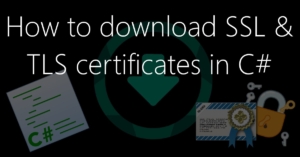How to download SSL/TLS certificates in C#
 This article is about how to download (or save) SSL/TLS certificates from any server by use of C#. Although nowadays certificates can be stored quite simply from the web browser, this is always associated with quite a few clicks. And at the latest when you want to store certificates from mail servers, etc., i.e. systems that can not be addressed directly in the web browser, a programmatic solution, as shown in this post, may be the easier way.
This article is about how to download (or save) SSL/TLS certificates from any server by use of C#. Although nowadays certificates can be stored quite simply from the web browser, this is always associated with quite a few clicks. And at the latest when you want to store certificates from mail servers, etc., i.e. systems that can not be addressed directly in the web browser, a programmatic solution, as shown in this post, may be the easier way.
All in all, I would like to introduce two variants today. One variant, which works only for HTTPS connections and another variant, which works for all TCP connections (like mail servers, etc.).
Download HTTPS/SSL certificates in C#
The first addressed solution works only for HTTPS connections and […]

 Today, there is only a very short article with an SQL statement which allows you to display the size of a MySQL database, as well as the description of how to read out the database size via phpMyAdmin. Let’s start with the SQL statement. To display the size of a particular MySQL database in MegaByte (MB), use the following SQL command:
Today, there is only a very short article with an SQL statement which allows you to display the size of a MySQL database, as well as the description of how to read out the database size via phpMyAdmin. Let’s start with the SQL statement. To display the size of a particular MySQL database in MegaByte (MB), use the following SQL command: Since Java does not have a function to pad strings on the left or right side, you either have to program such function yourself or use an existing library, such as Apache Commons. Because I recently needed a function that would pad a numeric string on the left side (= padLeft) with zeros up to a length of 8 characters, but did not want to include a whole library for such a simple task, the only option was to write a padLeft function myself.
Since Java does not have a function to pad strings on the left or right side, you either have to program such function yourself or use an existing library, such as Apache Commons. Because I recently needed a function that would pad a numeric string on the left side (= padLeft) with zeros up to a length of 8 characters, but did not want to include a whole library for such a simple task, the only option was to write a padLeft function myself. In this article, I want to show you how to disable the OPCache based caching for certain directories. (If you need a short introduction to the subject of OPCache, you should scroll down to the blue box in this article.) Although OPCache is a good idea in almost all cases, there are, as with many thing, situations where you should make an exception. Especially when it comes to the development or if a bugfix is to be tested, it can make sense to disable OPCache.
In this article, I want to show you how to disable the OPCache based caching for certain directories. (If you need a short introduction to the subject of OPCache, you should scroll down to the blue box in this article.) Although OPCache is a good idea in almost all cases, there are, as with many thing, situations where you should make an exception. Especially when it comes to the development or if a bugfix is to be tested, it can make sense to disable OPCache. In the following post there is once again a small Java code snippet, by means of which the standard mail program can be called/opened.
In the following post there is once again a small Java code snippet, by means of which the standard mail program can be called/opened.